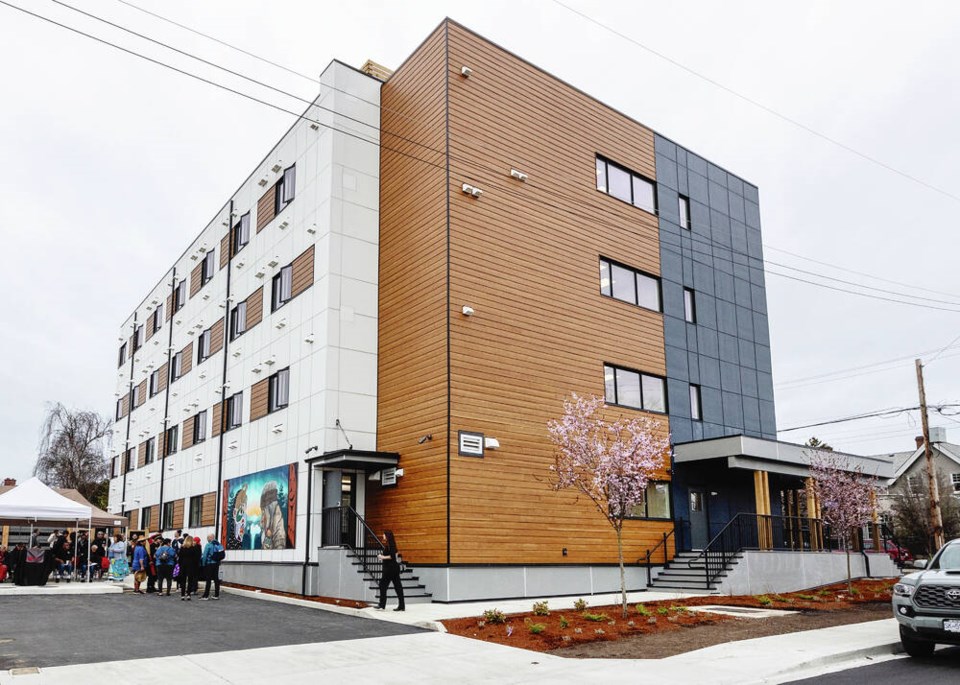A commentary. Hunt-Jinnouchi is executive director of the Aboriginal Coalition to End Homelessness Society; Stinson is CEO at Victoria Cool Aid Society; Daly is CEO at Our Place Society and Ibarra is CEO at Pacifica Housing.
New supportive housing sites are opening in the capital region this spring, against the backdrop of growing homelessness and concerns around community safety across the province.
The new sites are a cause for celebration, as they will provide adequate shelter and services to vulnerable individuals across different communities, in a way that temporary sites cannot.
All new sites will be staffed 24/7 so that actual supports and programming will be available to residents. Primary health services will also be readily accessible through different models.
Each of us — Aboriginal Coalition to End Homelessness, Cool Aid, Our Place, and Pacifica Housing — will operate one of these new sites. We are thrilled about the difference these will make.
Yet the new units are insufficient to meet the growing need or to make up for older or remaining temporary sites that lack adequate infrastructure and staffing.
The services provided at these new sites will not make up for insufficient access to recovery programs and related transitional housing, or specialized mental health and addiction services and safe supply. Recent provincial announcements send positive signals that some of these missing pieces are on their way but they have not yet arrived.
We hear calls for more security around supportive housing sites. We see investments being made in teams focused on managing visible homelessness, which primarily shuffles people across cities while not meeting their basic needs and not addressing the systemic causes of their homelessness, mental health and addictions.
Gaps remain and the missing pieces of the puzzle are those that make up the framework for success that already exists.
In order to move forward while ensuring the most positive outcomes for supportive housing, the following need to be in place:
• Adequate, consistent and transparent funding to safeguard critical infrastructure and services. Critical physical infrastructure includes appropriate buildings with self-contained units, functioning amenities and programming rooms.
Critical infrastructure also includes adequate administrative and front-line staffing levels with resources to provide training that is appropriate to the services provided.
Services include overdose response; mental health and addiction services; and culturally appropriate supports as well as outreach. Ready access to health care services that are on site, mobile or nearby are crucial.
• We also need a legal regulatory structure that is adequate for the service provided. The Residential Tenancy Act does not provide this.
We have proposed that amendments to the act take place to expand upon its application to supportive housing, so that both residents and providers have clear and effective rights.
As it is today, the act creates significant liabilities for supportive housing providers and communities, while at the same time limiting the rights of supportive housing residents. In this area, the act delivers uncertainty to all parties.
• Appropriate policing and good working relationship with police and all other first responders is important. We must strengthen trust among each other and with the communities we serve. We too often allow the lacking infrastructure to drive a wedge between us and the people we serve.
Supportive housing is distinct from just affordable housing or subsidized, non-market housing. While supportive housing began as a response to a range of support needs, it now serves a very specific demographic of people who require the lowest barrier housing and supports.
Over the past several years the complexity of needs of our clients has grown. Yet, infrastructure and staffing models have not kept up with the needs of our clients or circumstances surrounding the toxic drug supply.
There is a lot of good work happening and many examples of phenomenal success, but we seem to focus on what is not working.
There is hesitancy to make systematic investments in solutions while funds are lost on reactive, figurative and real firefighting.
It is when investments in people and tried and true solutions are made up front that every individual, business and community will feel safe. It takes speaking up, building trust, collaborating, leaving assumptions aside, welcoming supportive housing into every community and having the courage to do the right thing, which will bring the change we all seek.
We invite our communities to join us in this pursuit.



